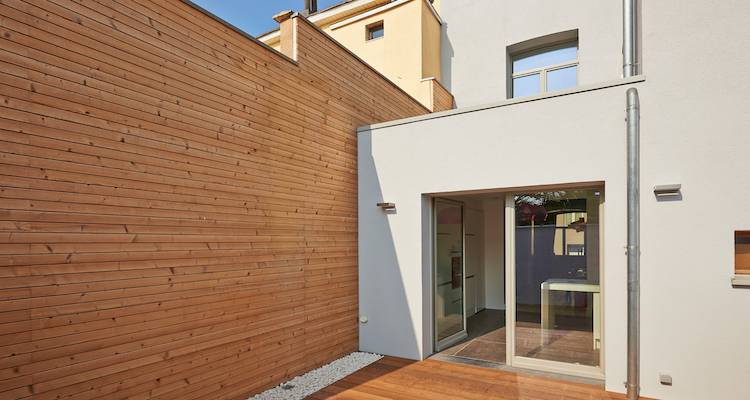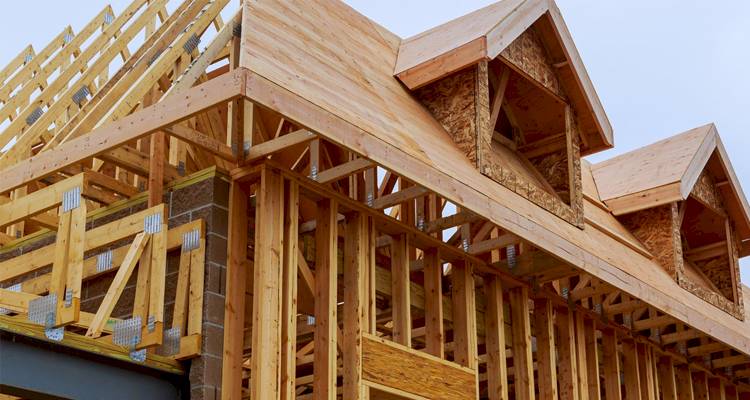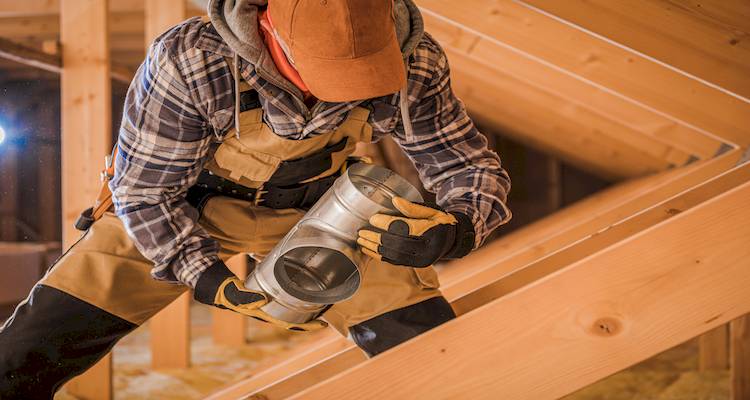Cost of Laying a Patio
- The average new patio costs around £1,200 in the UK.
- This job takes around 2 days for specialists to finish.
- Typical patio installation costs and what impacts prices you're quoted in 2025.
- What's involved in the job, material pros and cons, and expert advice from tradespeople.
- How to find a local patio installer using MyJobQuote.
Wondering how much it costs to lay a patio?
This guide covers everything you need to know about the cost of laying a patio in the UK. You'll find a breakdown of the prices by material, how much a patio builder costs in 2025, and much more!
Even if you're just exploring your options, it's a smart move to get a few quotes. It gives you the full picture about what's possible in your space with the budget you have.
With MyJobQuote, you don't need to commit to anything — all quotes from patio installers are fast, free, with no obligation to go ahead.
You'll find our full patio cost guide below.
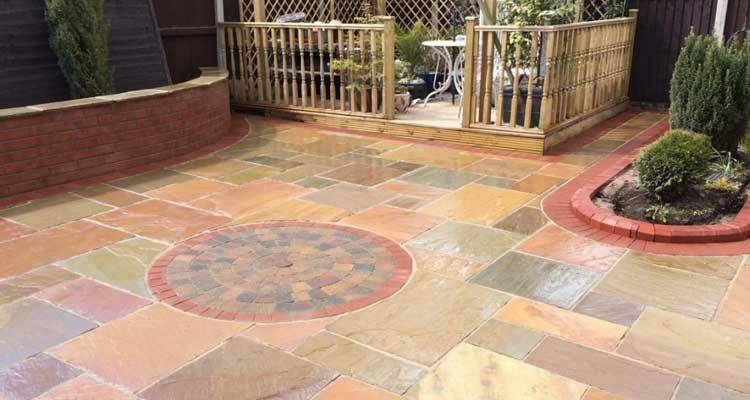
£1,200
Table of Contents
- How Much to Lay a Patio?
- How Much Does a Patio Builder Cost?
- What's Involved in Laying a Patio?
- What Impacts Patio Installation Costs?
- How to Lay a Patio
- Types of Patio Installations
- Patio Repair Costs
- What Alternatives to a Patio Are There?
- Patio Maintenance and Cleaning
- Cost of Patio Removal
- How to Find and Hire a Patio Installer
- FAQs
- Sources
How Much to Lay a Patio?
The cost to lay a patio in a standard 20 square metre area...
...is typically around £900 to £2,500, on average. This price includes the cost to excavate the area, lay the foundations, buying the patio slabs, and laying them.
What factors impact the patio costs you're quoted?
These prices will vary depending on the type of materials used. Budget options such as concrete and brick patio slabs cost around £900 to £1,600 for a medium-sized area, while premium slate patios cost between £900 and £3,800 and premium stone patio cost up to £4,200,
Which is better for a family garden: decking or a patio?
New Patio Prices
Below are some estimated costs of hiring a landscape gardener to build a small (10m²), medium (20m²), or large (40m²) patio:
| Patio Type | Patio Size | Avg. Cost |
|---|---|---|
| Stone | Small | £800 – £1,350 |
| Medium | £1,400 – £2,500 | |
| Large | £2,400 – £4,600 | |
| Brick | Small | £550 – £900 |
| Medium | £1,000 – £1,600 | |
| Large | £1,500 – £2,200 | |
| Slate | Small | £900 – £1,200 |
| Medium | £1,600 – £2,200 | |
| Large | £2,800 – £4,000 | |
| Concrete | Small | £550 – £1,100 |
| Medium | £900 – £2,000 | |
| Large | £1,400 – £3,600 |
Calculate the Cost of Laying a Patio
Want to get a better idea how much it costs to lay a patio?
If so, head over to our patio cost calculator.
The main thing you'll need is the length and width (in metres) of the area that you'd like to install a patio on.
While this calculator is a great starting point, getting quotes from local patio layers is the best way to understand the cost for your specific project.
Quotes you get through MyJobQuote are free, with no obligation to proceed.
How Much Does a Patio Builder Cost?
Labour Costs
Day rates for gardeners hover around £100, though in reality you’ll need two people on site. So, that’ll bring it closer to £200 a day.
Labour tends to swallow up around 25–35% of the total project cost. Broken down, that’s around £20–£40 per m² just for the manpower, before you even add materials, prep and waste removal.
Most installers will give you a total price for the whole patio rather than charging by the day. But it’s handy to know the average cost per square metre, just to check you’re not being overcharged.
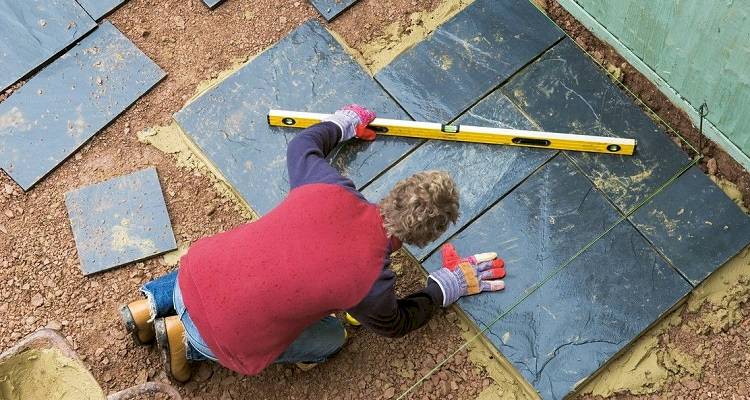
What is the approximate cost to lay porcelain paving slabs over an area of 16 x 16 feet, excluding the cost of the slabs? Additionally, how much would it cost to lay a concrete slab measuring 10 x 13 feet?
Timescales
How long a patio takes depends on the size, ground conditions, and weather. Here are typical scenarios:
| Patio Size | Typical Timescale | Assumptions |
|---|---|---|
| Small (≈10 m²) | ~2 days | Level ground, easy access |
| Medium (≈20 m²) | ~3 days | Standard prep and laying |
| Large (≈40 m²+) | ~4–5 days | May need extra prep/edging |
Patio work is best done in dry, mild weather. Heavy rain, frost, or freezing conditions can delay the job because mortar won’t set properly, and wet ground makes excavation and compaction harder. Most installers avoid laying in poor weather to make sure the patio lasts.
What's Involved in Laying a Patio?
So, exactly how much work is even involved in laying a patio?
Well, it's one of the bigger landscape gardening jobs, even for a relatively small patio area of 25 square metres.
There’s digging, levels, drainage and a fair bit of heavy lifting. That’s why most homeowners get a pro in, then compare a couple of quotes before they book.
Before the Job Starts
- Survey and measurements — The installer checks access, measures up, and confirms where any services (cables/pipes) run.
- Levels and drainage — Falls are planned to shed water away from the house (a gentle gradient). If runoff needs managing, you may add a channel drain or a soakaway.
- Spec and materials — Sub-base (Type 1 MOT), full mortar bed, and your chosen slabs. Porcelain/smooth stone usually needs a slurry primer on the back for good adhesion.
- Safety and setup — Tools and PPE lined up (dust mask, goggles, knee pads), plan waste removal/skip if lifting an old patio.
During the Job
- Strip out and prep — Lift any old surface and excavate to the right depth for sub-base, bed and slab thickness.
- Build the sub-base — Lay Type 1 MOT in layers and compact thoroughly (garden patios often allow ~100 mm compacted, adjusted for ground/loads).
- Lay the bed — A full mortar bed is laid (typically ~30–50 mm). Porcelain/smooth stone gets a slurry primer before it goes down.
- Set out and lay — Start from string lines, tap each slab level with a rubber mallet and keep the fall consistent. Typical joints: 5–10 mm for most calibrated stone, 3–5 mm for porcelain (always check the manufacturer’s guidance).
- Jointing and clean down — Once the bed has firmed up, joints are filled (mortar or resin/compound to suit the slab) and the surface is cleaned.
After the Job
- Curing and first use — Keep off heavy furniture/loads until bedding and joints have cured (often 24–72 hours, weather dependent).
- Snagging — Check edges, levels and water run-off; tidy any small imperfections.
- Care tips — Occasional cleaning, weed control at the joints, and avoiding harsh de-icers on sensitive stone will keep it looking sharp.
What Impacts Patio Installation Costs?
There isn’t one single price driver. Instead, it’s a mix of size, materials, prep, and how fiddly the job is. Here’s how to sanity-check quotes and see where the money goes.
Patio Size
Bigger areas mean more excavation, more sub-base, more slabs, and more time. As a rough sense-check, small patios (~10 m²) often land around £800–£1,100, while large (~40 m²) can reach ~£4,600 depending on spec and access.
Slab Type and Quality
You generally get what you pay for. Budget concrete starts from about £15 per m² (supply only), but cheaper mixes can fail sooner (air pockets + freeze/thaw). Natural stone and better-made concrete look sharper and last longer, typically up to £95 per m² (supply only).
| Patio Type | Avg. Cost per m² (supply only) |
|---|---|
| Stone | £40–£95 |
| Brick | £15–£50 |
| Slate | £50–£80 |
| Concrete | £15–£55 |
Looking across this guide, typical all-in costs (materials + labour) usually sit around £60–£120 per m². Use that as a quick yardstick when comparing fixed prices.
Ground Prep and Sub-Base
This is the hidden chunk that makes a patio last. Most installs need excavation plus a compacted sub-base (e.g., Type 1 MOT). Softer ground or areas that take more weight need more depth and time. If you’re flagging, allow £15–£60 per m² for the flags (supply) plus £75–£100 per m² for laying.
Falls and Drainage (SuDS)
Patios are laid to a gentle fall away from the house. Surface water should go to permeable ground or a soakaway, not the foul system. If there’s nowhere sensible for runoff, you may need channels/gullies or a soakaway — the cost of installing a soakaway typically runs £700–£1,000.
Access and Site Constraints
Narrow side passages, steps, long carries, trees/roots, or lots of spoil to shift will slow things down. Removing an existing patio or heavy spoil also adds waste costs (often ~£100+ depending on volume). If there’s a lot to clear, a single skip hire cost can be more efficient than multiple trips.
Pattern, Edging and Extras
Simple stretcher bond is quickest. Intricate patterns, tight curves, steps, brick edging, recessed manholes, lighting, or planters all add labour time and materials. Lovely touches — just allow for them in the quote.
Labour Rates by Region
Where you live matters. London and the South East trend higher due to overheads and parking. As a ballpark on larger jobs: bigger firms in London ~£2,400–£2,600, in the North ~£2,000–£2,200; many homeowners use sole traders at roughly ~£2,000 (London) vs ~£1,750 (elsewhere).
Season and Weather
Wet/frozen ground slows excavation and affects mortar. Most installers avoid laying in heavy rain or frost, which can stretch timelines.
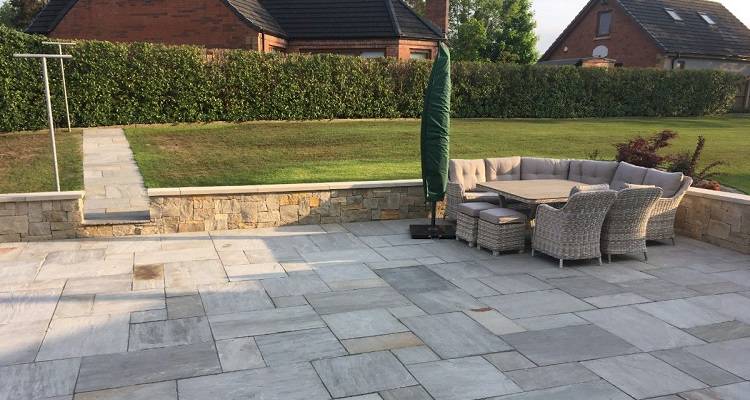
Specs and site dictate price. Ask for an itemised, written quote that shows excavation depth, sub-base build-up, drainage/falls, laying pattern, jointing, waste removal, and any extras. It makes comparing like-for-like much easier.
Should I use concrete or paving slabs for a patio area in my garden?
How to Lay a Patio
On a tight budget? You might consider installing a patio yourself. It’s hard, heavy work and best suited to confident DIYers — for most people, hiring a pro is the safer bet.
If you do go DIY, be sure to factor in the price of materials as well as the tools and safety gear you’ll need.
The below table sets out the costs of buying or hiring tools for a patio installation:
| Tools | Avg. Cost |
|---|---|
| Cement mixer | £100 – £4,000 (£15 for daily hire) |
| Pegs | £3 – £5 per pack |
| Trowel | £4 – £65 |
| Rake | £16 – £45 |
| Wheelbarrow | £35 – £170/£8 to £10 for daily hire |
| Tape measure | £2 – £50 |
| Spirit level | £4 – £160 |
| Rubber mallet | £5 – £10 |
Here is a breakdown of the typical safety equipment you may need:
| Safety Equipment | Avg. Cost |
|---|---|
| Dust mask | £1 – £20 |
| Safety goggles | £0.50 – £30 |
| Rigger gloves | £2 – £10 |
| Knee pads | £2 – £50 |
| Ear defenders | £2 – £40 |
| Steel toe-capped boots | £15 – £130 |
Types of Patio Installations
The type of patio you choose will really depend on your own personal preferences as well as your budget.
Here is a breakdown of the different patio types, which includes pros and cons, along with the average costs:
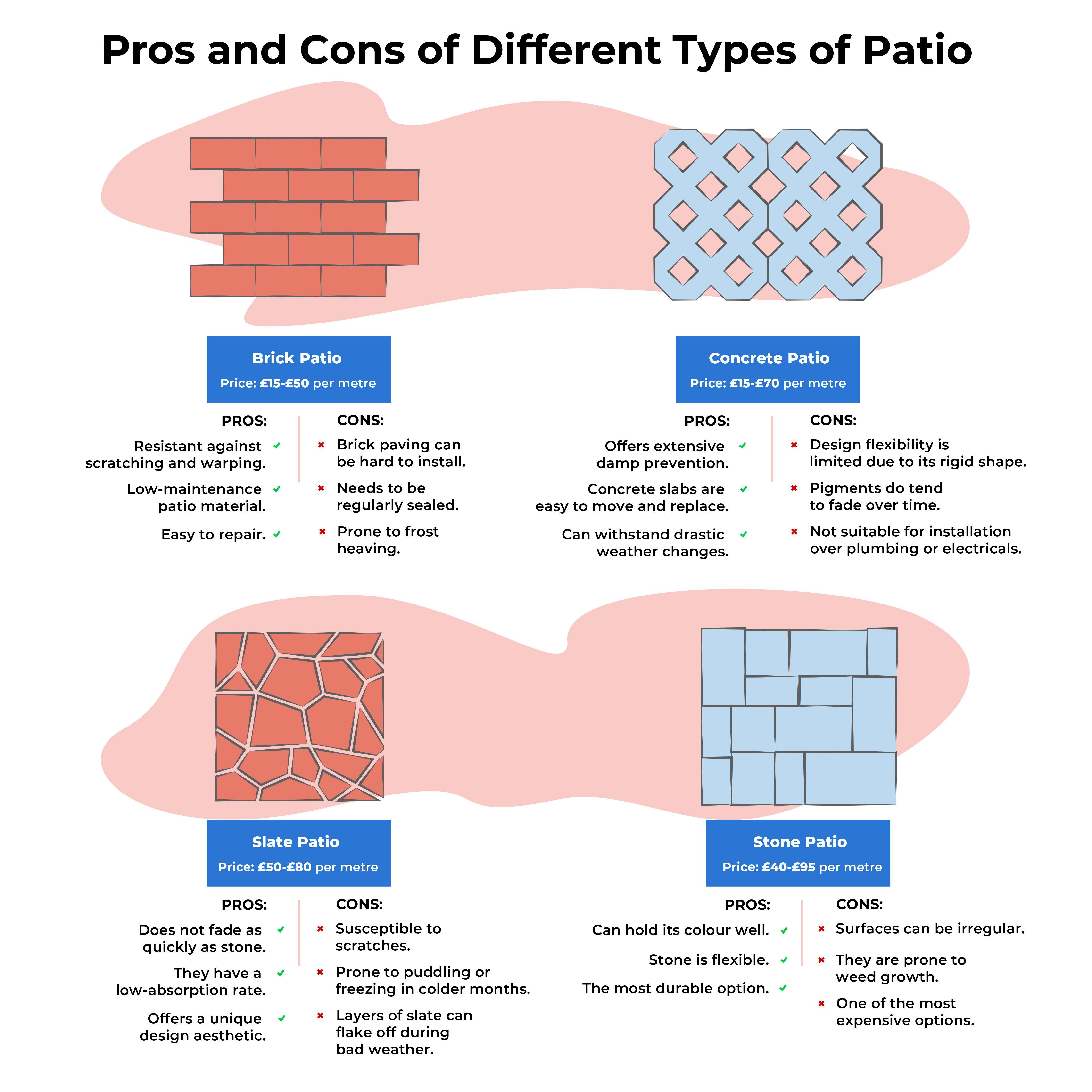
Patio Repair Costs
The average cost of repairing a patio tends to be significantly lower than the cost of replacing one.
However, this will depend greatly on the scale of repair work required. Patio repairs are usually completed within one day, so you should expect to pay around £100 for professional repairs or up to £200 per day if a general labourer is working alongside them.
What would it cost to relay an existing patio? Slabs are 18" by 18".
But a guide you can use is a rough cost of between £130-£180 per m2. Just find out the area size and work it out with those numbers and that will give you your minimum and maximum.
Also an extra cost of £250-£400 per manhole cover if they are needed. That is all inclusive of labour and materials."
Sinking
If you notice sunken slabs, lift the affected pieces and inspect the bed. Rebuild the support with the correct laying material for that patio (e.g., a full mortar bed for flag paving), then relay the slabs level with the surrounding area and reinstate the joints.
The area should then be cleared before putting the pavers back in place, making sure they are flush with the rest of the patio.
To finish off, dry sand will be added on top of the pavers before sweeping and tamping until all joints are filled.
Cracking
If you've had your patio for a long time, you may start to notice small cracks appearing on the surface.
These can be repaired by applying cement and sand to the area to fill in the gaps and cover up the cracks.
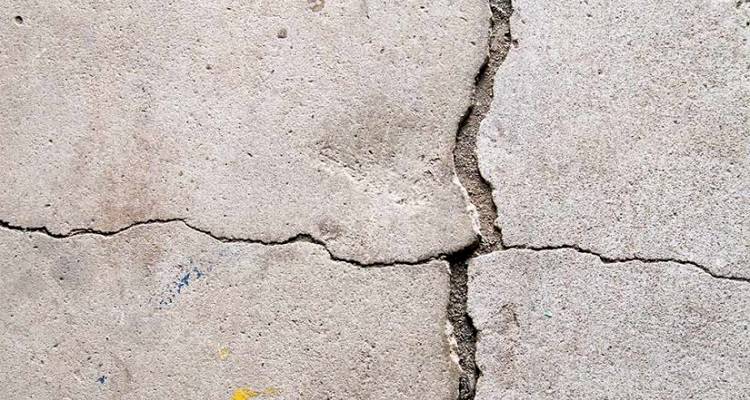
If you have a concrete patio with a hairline crack, then the damage can be chipped away using a chisel (£4 to £25) and a club hammer (£6 to £30). The removal should reach a depth of at least 15mm.
Once this is complete, the area should be cleaned of all dust and debris, then PVA adhesive (£4 to £20) should be diluted and applied to the hole.
After the glue becomes tacky, repair filler (£6 to £30 per bag) should then be added to the area. To ensure everything is level, a float should be used. Then, the final step is to cover the hole with a polythene sheet (£6 to £20), which should be left for three days to allow it to harden.
Re-jointing
If your garden paving or blocks start to become loose, this may be because the jointing mortar has failed and will need to be replaced.
So, how do you do this?
To do this, the existing mortar will need to be removed with a hooked tool (£2 to £10) or weeding knife (£1 to £30).
In some cases, the mortar may be quite hard to remove, so a diamond blade (£6 to £60) will be required, which should be attached to a cut-off saw (£100 to £800).
You can choose to buy a saw or hire it for around £15 to £20 per day. They will be used to rake out the mortar and open up the joint.
Once all the old mortar has been removed, the area will need to be cleaned thoroughly, making sure that any dust or debris is removed using a brush or a pressure washer, which costs around £70 to £2,000 to buy or £20 to £160 per day to hire.
After the area has been cleaned, new mortar can be applied to the gaps. The right sand and cement will be applied to each gap, with the ratio of materials depending on the size of the gaps.
For very narrow joints on block paving (typically ~2–5 mm), use kiln-dried silica sand. For wider joints on flag paving, use an appropriate mortar or a resin jointing compound to the manufacturer’s instructions.
This should be mixed first before spreading it on the patio, making sure that all the joints are filled.
Once the joints are completely full, a brush should be used to remove any excess sand off the patio surface. The jointing material will then harden, and your patio will look brand new again.
What Alternatives to a Patio Are There?
If the patio’s sorted but you’d like another way to wander through the space, these alternatives could work well.
Gravel Paths
Gravel paths are quick to put down and easy to tweak later. Want an uncluttered finish that lasts? Lay down a firm sub-base along with a weed membrane. Then, use edging to keep stones from wandering onto lawns or beds.
Best for: Quick, budget-friendly paths and relaxed seating areas.
Material cost: £20–£50 per m²
Pros
- ✔ Quick to install.
- ✔ Lots of colours and sizes.
- ✔ Hard-wearing when you lay it over a firm sub-base and membrane.
Cons
- ✖ You’ll need to tidy it up regularly to keep it looking good.
- ✖ Trickier to clear in snow and ice — scraping will move the stones.
Bark Mulch Paths
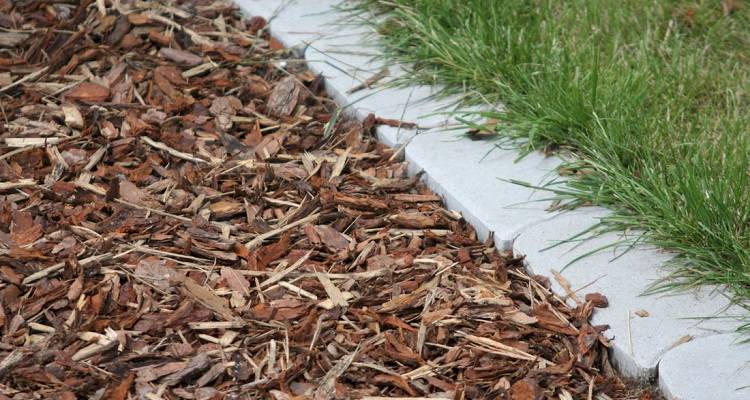
Bark gives you a natural, soft finish underfoot. However, it'll compress and break down, so be sure to top it up now and then.
It works best on top of a breathable membrane with edging to keep it in place. If you’re clearing a lot of old borders or green waste, a skip is worth having.
Planning a bigger garden project? Typical landscaping costs vary by materials, access, and drainage.
Best for: Natural-looking garden paths and borders.
Material cost: £90–£180 per bulk bag (coverage varies by depth)
Pros
- ✔ Helps suppress weeds.
- ✔ Soft underfoot and easy to top up.
Cons
- ✖ Not great for heavy foot traffic — it shifts about.
- ✖ Leaf blowers and strong jets can scatter it.
Garden Decking
Decking is brilliant for levelling awkward spots and creating a clean seating area fast. Timber needs periodic care; composite costs more up front but is lower-maintenance.
Best for: Level seating space on uneven ground.
Material cost: £15–£90 per m² (timber or composite)
Pros
- ✔ Warm, natural look.
- ✔ Flexible designs for small or large spaces.
- ✔ Hardwood can last decades if cared for.
Cons
- ✖ Cheaper boards may only last 10–15 years.
- ✖ Needs ongoing maintenance to avoid rot and wear.
Resin-Bound Surfaces — Costs and Considerations
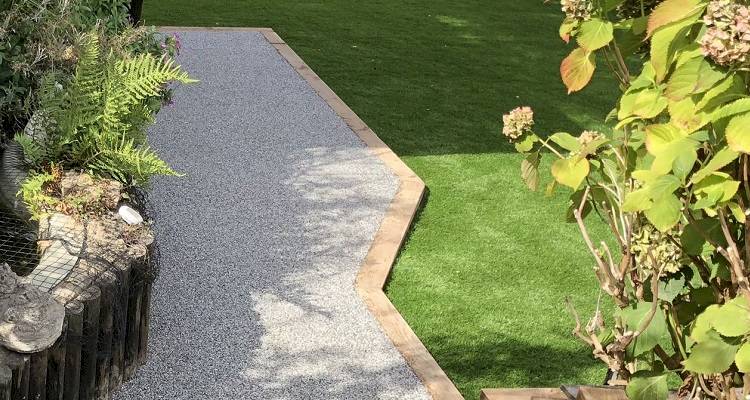
Resin-bound gives you a smooth, modern look that drains surface water through the mix when laid on a suitable base. It wants solid prep and neat edging, so get itemised quotes.
Best for: Smooth, modern finish with good drainage.
Material cost: £60–£90 per m²
Pros
- ✔ Permeable, so it helps with surface water.
- ✔ Clean look and comfortable underfoot.
Cons
- ✖ Can encourage weed growth if not maintained.
- ✖ Resin-bonded (not bound) options aren’t permeable and can pool water.
Patio Maintenance and Cleaning
To ensure your patio lasts, you should conduct regular cleaning and maintenance. There are different methods for each material, including:
Stone Patio Maintenance and Cleaning
Stone is sometimes susceptible to mildew and algae growth. To remove dirt, you can simply use dish soap and water, which can be applied using a brush, although avoid a wire brush as this can scratch the surface.
For stubborn dirt, use a stone-safe cleaner recommended by the slab manufacturer. Avoid acidic products on calcareous stone (e.g., limestone) as they can etch the surface.
For stains, you can use a deck cleaner or a degreaser which should be rubbed onto the stone with a nylon brush then rinsed with water.
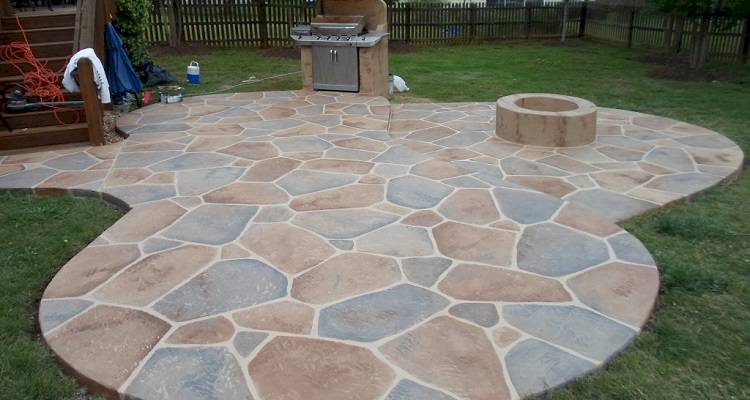
To maintain your stone patio, you should brush it to remove any debris and pull out any weeds at least once a week. You can also pour sand in between your stones to prevent weed growth.
Professionals will also advise you to cover your patio with a surface protector in the winter to prevent moss and dirt build-up.
If you would prefer to hire a professional to clean and maintain your stone patio, then you should expect to pay around £150 to £400 for jet washing, although the price will vary depending on the size of your patio.
Slate Patio Maintenance and Cleaning
If you have a slate patio, you will need to clear any dust or dirt regularly by using a brush and dish soap. You should try to avoid using harsh chemicals on a slate patio, as it's a natural material that is easily damaged by using certain detergents. You will also need to conduct thorough cleaning around two to three times a year.
What about stains on a slate patio?
If you have any stains on your patio, then you should apply a slate cleaner mixed with water and leave it on the area for ten minutes, then rinse it off with a hose. The stain can then be scrubbed with a stiff brush.
Consider sealing exterior slate with a suitable breathable sealer if the manufacturer recommends it. For cleaning, use a pH-neutral cleaner and a soft brush; avoid abrasive pads that can mark the surface.
Concrete Patio Maintenance and Cleaning
When cleaning and maintaining your concrete pathway, you need to be careful about harming the surrounding grass and plants. Some regular methods include brushing any leaves or debris off the pathway with a brush or leaf blower, which costs around £30 to £90.
To remove any dirt or grime, you should wash the path regularly with a garden hose that has a nozzle with concentrated water flow. You should direct the hose at the path rather than the grass to avoid water pooling.
For stubborn stains, you can hire someone to power wash your path, or you can do it yourself if you have the equipment. For any remaining stains, you should rub the area with a stiff scrub brush and use a tiny amount of detergent. Then, once removed, rinse your patio with water.
Brick Patio Maintenance and Cleaning
For regular brick patio maintenance, you should sweep the area at least once a week, making sure you use a brush with stiff bristles. You should also hose it regularly, as this will remove any brick particles and grout which may have come loose.
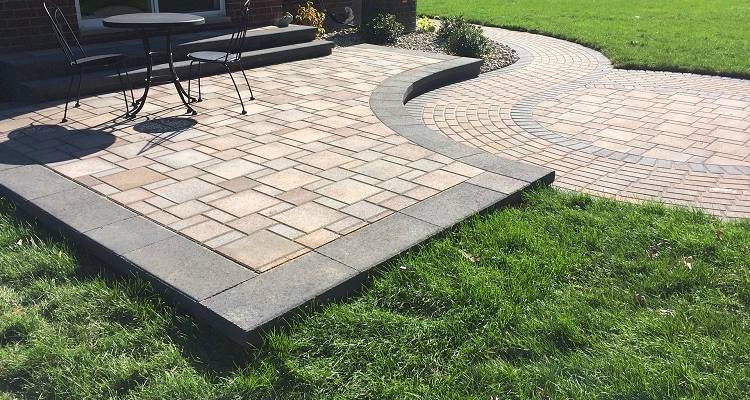
Regular weeding is also important if you have a brick patio, as weeds that are left can eventually cover the brick completely, so you’re best removing them as soon as possible. This will involve removing the weed itself, as well as any leaves, branches and dirt.
For easy maintenance, you may want to add a sealant to your brickwork, which costs around £3 to £6 per square metre for sealing, although this will vary depending on the size of your patio. You may also want to pay extra for power washing, which should be conducted two or three times a year.
Cost of Patio Removal
Taking up an old patio is normally priced as labour – you’ll also want to cover waste removal. A couple of workers will run to roughly £200 a day. As for getting rid of the waste, that’ll be about£100. Alternatively, you can look into skip hire costs. For this, you’ll probably pay between £60–£400. Concrete always takes a little longer than loose paving, so be ready for the higher end if that’s what’s underfoot.
| Patio Size | What’s Included | Typical Removal Cost | Approx. Cost per m² |
|---|---|---|---|
| Small (≈10 m²) | Lift slabs/break out light concrete, load out, waste | £250 – £500 | £25 – £50 per m² |
| Medium (≈20 m²) | As above, more waste volume | £400 – £700 | £20 – £35 per m² |
| Large (≈40 m²) | As above, 2–3 labour days and larger skip | £700 – £1,000 | £18 – £25 per m² |
Most slab patios can be lifted and cleared for around £18–£35 per m², including waste. If it’s one solid slab of concrete, you’re nearer £25–£45 per m² thanks to the extra graft and it involved.
What nudges the price up, though? The thickness and type of surface, if the sub-base is deep, if access is tricky, or if you need a skip to cart it all away.
How to Find and Hire a Patio Installer
Who you choose to lay your patio can make or break it. A good installer will make sure your patio looks good and stands the test of time. Here are a few checks to watch out for before you agree to anything:
- Get a few quotes. Get at least 3 quotes from patio installers near you. That’s enough to spot if someone’s taking the mick or coming in strangely cheap.
- Check their know-how. Go for someone who’s laid plenty of patios before – five years plus in the trade is a decent marker.
- Ask to see their portfolio. Take a look at photos they've uploaded to their MyJobQuote profile. Seeing past patios is the easiest way to judge their standard of work.
- Read the reviews. Spend a few minutes scrolling reviews, or check their MyJobQuote profile to see all their feeddback from other homeowners – this can save you a lot of bother later.
- Cover yourself. An installer worth their salt should have insurance. If they don’t? That’s a red flag.
- Check the small print. Make sure it includes things like clearing rubbish, laying the base, and finishing the joints.
- Ask about guarantees. Decent installers will usually back their work, especially if it sinks or the joints give way.
- Find out when they’re free. Skilled tradespeople are busy people – book early so you’re not left waiting.
FAQs
Do I need planning permission to install a new patio?
If the work involves significant embanking/terracing or you’re in an Article 4 area, extra permissions may be needed. If your home is listed or within the curtilage of a listed building, speak to your local planning authority as consent may be required depending on the scope and impact.
Any electrical work outdoors must comply with Part P of the Building Regulations. Certain work is notifiable; use a registered electrician or notify Building Control before starting.
When in doubt, check with your Local Planning Authority and Building Control before you begin.
How much would it cost to have a small patio laid?
What sand to use when laying patio slabs?
What is the best patio cleaner?
There is a range of these types of cleaners available at most DIY stores and online. However, these types of cleaners may not last as long as some of the stronger chemical cleaners, but they are much safer to use and much better for our environment.
How much type 1 do I need for a patio?
As a guide, 1 tonne of MOT Type 1 typically covers roughly 10–12 m² at about 50 mm compacted depth. Actual coverage varies with moisture and compaction. Use this as a starting point alongside your measured area and specified layer depth.
Sources
https://www.planningportal.co.uk/permission/common-projects/patio-and-driveway/building-regulations
https://www.homebase.co.uk/ideas-advice/garden-and-outdoor/patio-decking-and-fencing/how-to-lay-a-patio/
https://www.barbourproductsearch.info/pros-and-cons-of-timber-decking-blog000470.html
https://www.mainlandaggregates.co.uk/gravel-driveway-construction-guide
https://www.qualitytilecare.co.uk/slate-floor-tiles-cleaning
https://www.aspaving.co.uk/single-post/how-to-repair-a-patio
https://lovelygreens.com/create-wood-chip-garden-paths/



